Estimated reading time: 7 minutes
Share this article

- Astrology of Natal Charts
- Astrology of Relationships
- Personal Growth and Psychology
- Astrology for Predictions
- Horoscopes and Future Forecasts
- Astrological Talismans
- Formula of the Soul
- Numerology
- Astrological Tarot
- Global Astrology
- For Beginners in Astrology
- For Professional Astrologers
- Advancing as an Astrologer
Read for 7 minutes
What is this object? Each of us has been familiar with the constellation known as the Little Dipper since childhood and can easily identify its shape in the night sky. Despite only being able to see seven of its brightest stars, there are actually 25 luminous bodies that make up the Little Dipper (also known as the constellation’s alternate name).
What is its significance? The constellation of the Little Dipper has played a crucial role in all geographical discoveries throughout history, as it houses Polaris – the guiding star for curious explorers. What other noteworthy features does this constellation possess?
Myth of the Little Bear constellation
Throughout history, humanity has crafted numerous tales surrounding the enigmatic Little Bear constellation.
One such legend recounts the extraordinary birth of Zeus, the ancient ruler of the Greek gods. Fearing a prophecy that foretold his downfall at the hands of his own child, Cronus, Zeus’s father and a powerful titan, devoured each of his offspring as they were born.
However, Rhea, Zeus’s mother, employed a clever deception when it was time for Zeus to enter the world. Instead of presenting Cronus with a baby, she offered him a stone. Meanwhile, Zeus was secretly taken to the highest peak of Crete, where he was diligently cared for by two devoted nymphs, Melissa and Kinosura. These nymphs tirelessly attended to the divine infant day and night, ensuring his safety and well-being.
Eventually, Zeus grew strong enough to challenge his father and claim his rightful place as the ruler of Olympus. In gratitude for their unwavering support, Zeus bestowed upon Melissa and Kinosura a celestial honor. Melissa was immortalized as the constellation Big Bear, while Kinosura became the Small Bear constellation, both shining brightly in the vast expanse of the night sky.
It is important to note that if you are interested in understanding how celestial bodies influence your life, it is recommended to consult the analysis of your Natal chart.
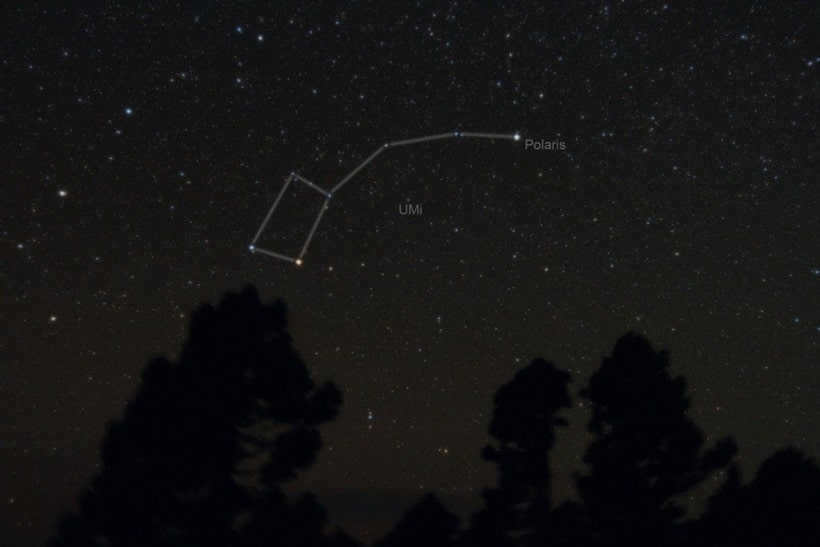
There is another story that recounts the early years of the Greek ruler of the deities: he was fed by Amalthea, the heavenly nanny goat, and two bears, who were subsequently immortalized in the sky.
Another tale involves Callisto, the daughter of King Lycaon, who resided in Arcadia. She possessed such extraordinary beauty that it aroused the envy of the queen of the gods, Hera. In her anger, Hera transformed the princess into a fearsome creature.
The son of Callisto and Zeus, named Arcades, had a passion for hunting and came close to accidentally killing his own mother with an arrow. However, Zeus intervened and saved Callisto’s life. To protect Callisto from Hera’s scheming, Zeus elevated her to the heavens and transformed her into the constellation of the Little Dipper. As a loyal companion, Arcades Zeus also ascended to the sky, giving rise to the constellation Volopassus. One of the stars in this constellation, Arcturus, is known as the “Guardian of the Bear.”
There are various myths and legends associated with these constellations in different cultures around the world. It is not surprising considering how prominent they are in the night sky. Many of these myths focus on the close relationship between the Little Bear constellation and Polaris. These stories often involve animals. For instance, the Kazakhs referred to the Big Dipper as a horse, with the Little Dipper being portrayed as a harness around its neck. Polaris is depicted as a nail with a rope attached to it. In Indian mythology, it is seen as a monkey whose tail clings to the center of the universe. It is important to note that individual stars have little impact on one’s life. To assess your strengths, weaknesses, and potential directions, it is advisable to create an Individual Development Plan that provides comprehensive guidance.
The Ursa Minor, also known as the Little Bear, is located at the North Pole, making it visible in the northern hemisphere at all times. The Ursa Minor constellation, or UMi, has a similar shape to a ladle, like the older constellation. However, the handle of the Ursa Minor has a slightly different shape.
The “tail” of the Ursa Minor is marked by Polaris, which remains stationary, allowing for easy determination of the northern direction. By orienting oneself towards Polaris, one can determine their latitude, as the height of Polaris above the horizon in degrees corresponds to the latitude of the observer’s location. This knowledge was utilized by Phoenician sailors over 1,000 years ago, giving them an advantage over other nations in navigation.
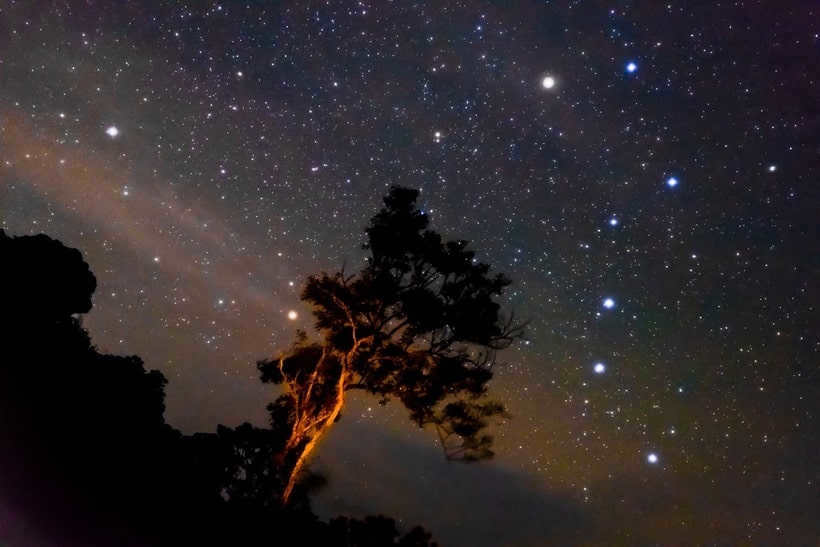
Throughout the year, the Little Bear constellation revolves around Polaris, moving in the opposite direction of the Sun. Due to its location in Russia, this cluster of stars is always visible and never hides behind the horizon.
The Big Dipper constellation, which is situated further away, is much more well-known than the Little Dipper. So how can one locate the latter? Polaris lies in a straight line from the two outermost stars of the Big Dipper. This method has been known since ancient times and remains incredibly simple.
In terms of size, the constellation is relatively small, covering an area of 256 square degrees. As a result, it ranks in the 56th position among other star groups.
The most brilliant stars of the Little Bear constellation
It is worth mentioning the names of the stars that are part of the Little Bear constellation:
- α – Polaris;
- δ – Yildun;
- ε – Urodelus;
- ζ – Alifa al-Farkadin;
- η – Anwar or Allaso;
- β – Kohab;
- γ – Ferkad.
The last two are also known as the Protectors of the Pole.
Polaris: The Alpha of the Little Bear Constellation
This particular star may not appear remarkable at first glance, as its brightness measures only 1.97 m and it may seem similar to other stars. However, what distinguishes Polaris from the rest is not just its proximity to the astronomical North Pole.
Polaris is actually located quite far from us, at a distance of 447 light years, making it unlikely for humanity to reach it in the foreseeable future. While many people are familiar with the name of the Little Bear constellation, few may consider the number of stars that comprise it. Interestingly, Polaris is actually a triple star system.
The central star within this system is a supergiant, boasting a mass 6.5 times greater than that of our Sun. Additionally, it shines 2,000 times brighter than our Sun.
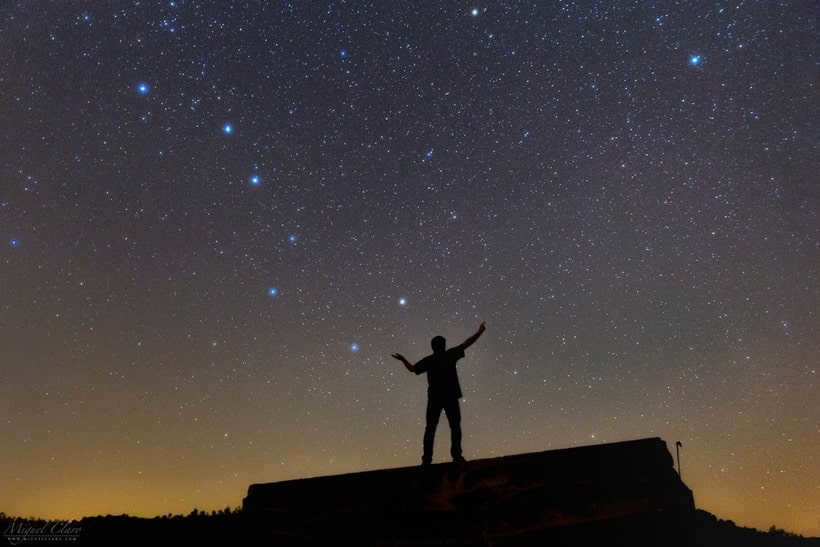
The second star is positioned 2,400 astronomical units away from the first one. It shines at a brightness of 9 m, making it visible through a basic telescope. It has a mass that is 1.39 times that of the Sun. This star completes a full orbit within a span of 100,000 years.
This celestial body was discovered in the late 18th century by astronomer Herschel, who also noted an intriguing optical illusion: the star’s yellow-white light appears greenish due to distortion.
Located near the giant star itself is the final member of this group of luminaries – Polaris B. This star is also larger than the Sun, with a size that is 1.26 times greater, and completes its orbit in a period of 30 years.
This particular cepheid, which is part of the constellation Ursa Minor, is the closest one to us. It possesses an intriguing characteristic of gradually dimming over time. In fact, just a mere century ago, its luminosity underwent much more significant fluctuations. However, its overall brightness is steadily increasing.
At present, Polaris is the nearest celestial body to the North Pole. Nonetheless, this will not remain the case indefinitely.
Polaris may currently be the closest star to the North Pole, but its position will eventually change. Due to the Earth’s axis precession, by the year 2102, Polaris will approach the North Pole to its maximum proximity and then begin to move away. In the year 3200, Gamma Cepheus will take its place, and another 10,000 years later, Vega, the alpha star of Lyra, will assume this position. Interestingly, Vega already occupied this location approximately 15,000 years ago.
Yildun is the delta of the Ursa Minor constellation
Unlike Polaris, this celestial body is located at a distance of only 172 light-years from our planet, and it is relatively young in terms of cosmic objects, with an age of approximately 170 million years. In terms of size, it is 2.8 times larger than our Sun, and its surface temperature is around 9900 K. These unique features indicate that Yildun is a prototypical white dwarf.
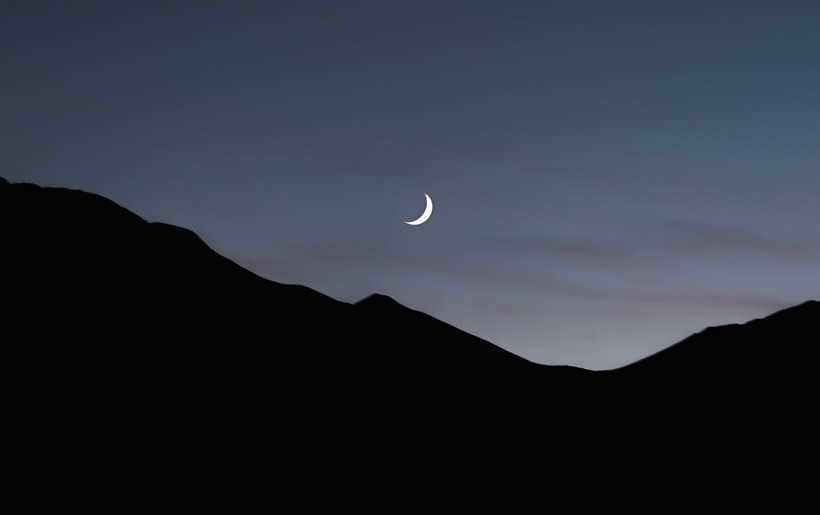
Furthermore, it stands out for its exceptionally rapid rotation, resulting in a noticeably flattened shape of the celestial body. After 700 million years, Yildun, much like the Sun over an extended period, will evolve into a red giant. This, coupled with the diminishing distance between our systems, will ultimately result in a gradual amplification of the luminosity of the delta in the constellation of Ursa Minor.
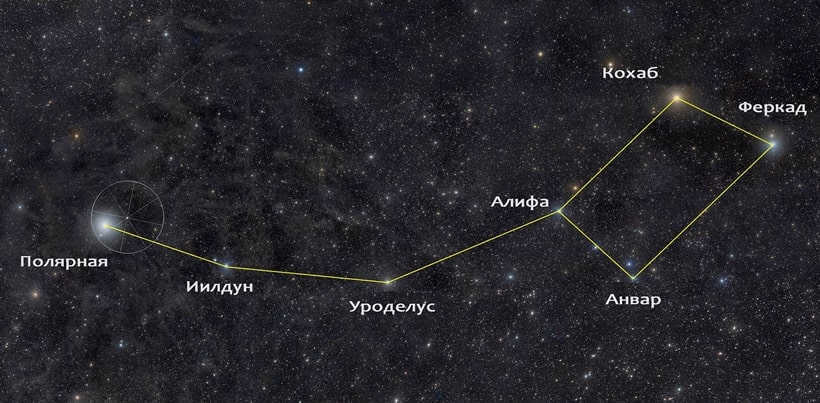
Urodelus: A notable component of the Little Bear constellation
Urodelus is comprised of a binary star system, with the primary star being an orange giant. This star is 19 times larger than our Sun, three times more massive, and 225 times brighter. Surprisingly, despite its size, it is not significantly hotter than our Sun, thanks to its significantly larger surface area.
Unfortunately, there is limited information available about the secondary star in the system. What we do know is that it is a white star in the main sequence and has an unusually short orbital period of just 39.5 Earth days. As the smaller star eclipses the larger one from our perspective, it creates a flickering effect. These characteristics lead scientists to classify Urodelus as an Algol-type variable star.

Simultaneously, our systems are rapidly approaching: currently they are 300 light-years apart, but every second the distance decreases by 10.5 km.
Alifa represents the zeta of the Little Bear
It is located 337 light-years away from our system, yet its luminosity of 4.2 m is rather ordinary. Its volume surpasses our own luminosity by a factor of 6, resulting in a brightness that is 191 times greater. Furthermore, Alifa is 3,000 K hotter.
Moreover, this star in the Ursa Minor constellation is known as Anwar al Farkadin. It is situated in close proximity, just 96 light-years distant, and possesses a magnitude of only 4.95 m.

Allaso is also a binary star. The primary star in the pair is a white-yellow dwarf with a size comparable to that of our two Suns, 1.66 times more massive, and slightly hotter.
The other component of this system has not yet been sufficiently investigated. We have information about its spectrum – it is a red dwarf, and we know the distance to the neighboring star is 13 light years. Despite the considerable distance, the gravitational attraction between these stars keeps the system intact.
Cohab is the beta version of the Little Dipper.
It serves as the second most luminous orange giant in the constellation of Ursa Minor. With a size 42 times greater than that of the Sun and a mass 2.5 times heavier, Cohab outshines its counterparts by emitting 400 times more light. The sheer intensity of Cohab’s radiance would result in the incineration of all the planets within our solar system, if it were situated at its core.

By deviating from it by 3.4 seconds on the celestial chart, a diminutive star with an 11.3 m emission comes into view.
Kohab also possesses an exoplanet. Astronomers recently stumbled upon a celestial object akin to Jupiter, but with a weight six times greater, a significantly higher temperature, and an incredibly short orbital period. This planet completes its orbit around the star in just 522 days.
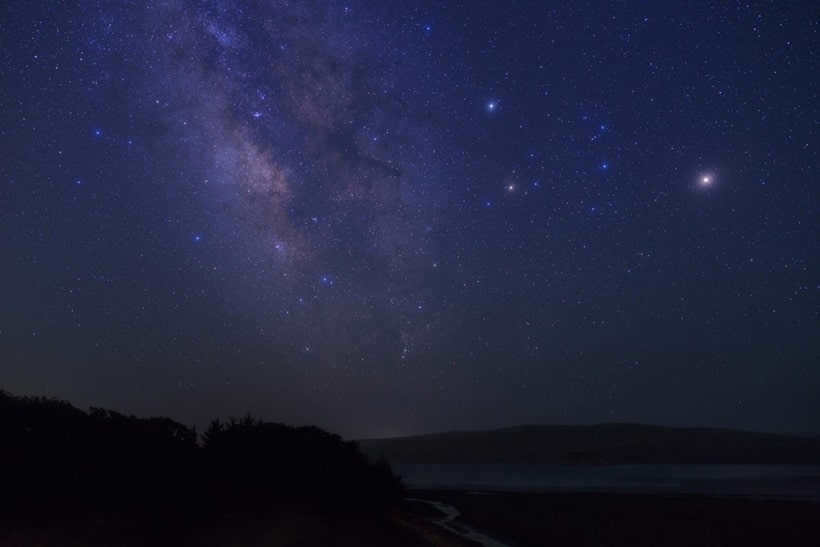
Ferkad, a member of the Little Dipper, holds the position of gamma.
This star is a typical white giant, dwarfing our Sun in size by nearly 15 times and surpassing it in mass by 8 times. Its luminosity is an impressive 1,100 times that of the Sun. Despite being located 480 light years away from our solar system, Ferkad shines brightly in the night sky, boasting a magnitude of +3.
Ferkad also exhibits variability, classified as a Shield delta variable. It undergoes surface pulsations, causing its brightness to fluctuate by 0.05 magnitudes over a cycle lasting 3.43 hours.
Adding to the intrigue of this celestial system is the discovery of an elliptical dwarf galaxy in 2005, which shares the same name as the star. This galaxy, however, is not part of the Milky Way, but rather serves as its companion.

The Little Bear constellation is located in the Northern Hemisphere of the sky. It is often referred to as the “little sister” of the Big Dipper, which is the most well-known part of the cosmos.

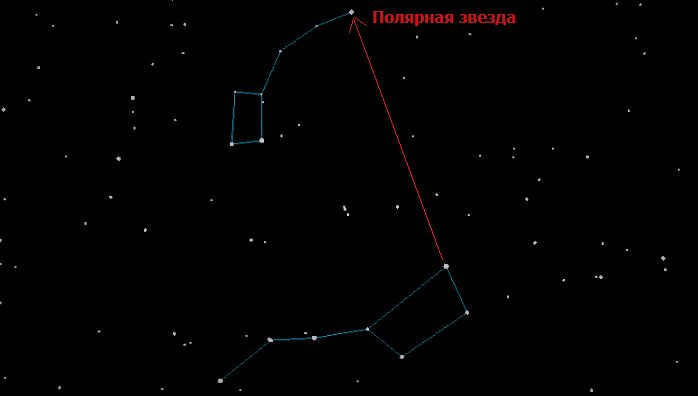
Currently, the location of Polaris is where it is. However, this will change within the next century. This phenomenon is actually caused by the Earth’s axis precession.
It is important to mention that the Little Bear constellation is situated close to the celestial north pole and is easily observable. Despite its relatively small size, it is ranked 56th in terms of area, occupying only 256 square degrees.
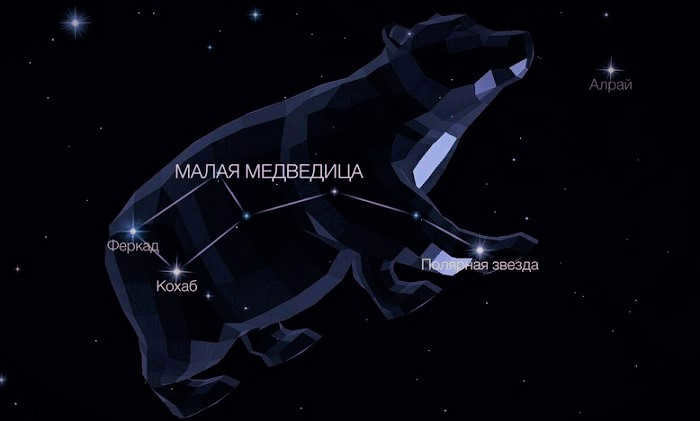
Myths and Legends Surrounding the Little Bear Constellation
Interestingly, the tales surrounding this particular region of the night sky are intricately connected to the Big Dipper.
In Greek mythology, the Big Dipper represented the nymph Callisto, while the Little Dipper symbolized her faithful canine companion.
However, there exists an alternative explanation for the formation of this constellation. It is said that the seven stars in this area are actually the Hesperides, who were the daughters of Atlas. These divine beings were entrusted with safeguarding the golden apples in Hera’s garden. In recognition of their unwavering loyalty, Hera immortalized them by placing their constellation in the celestial sphere.
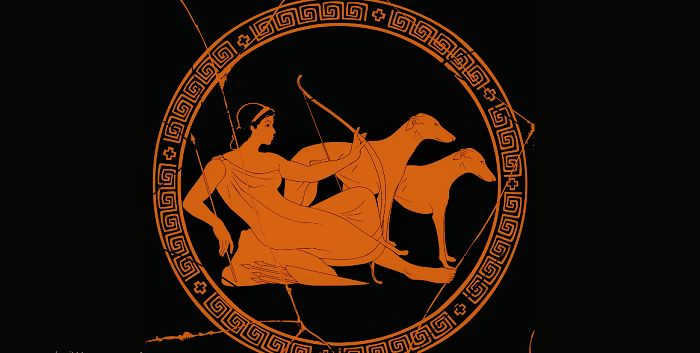
Stars composing the constellation Ursa Minor
An interesting characteristic of this region is that the central celestial body is Polaris. Indeed, it is the alpha star. . . which forms a complex system.
Polaris, without a doubt, stands out as the most luminous star. Not only within this vicinity, but also across the entire northern hemisphere.
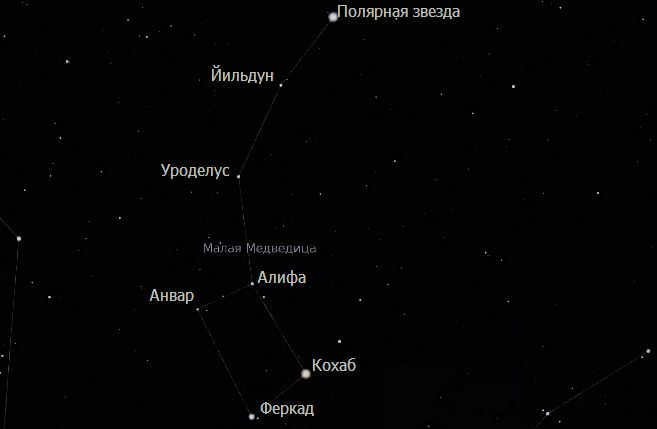
Regarding Beta, it is known as Beta Cohab. It is classified as an orange giant. On the other hand, Gamma, also known as Thercade, is a white giant. Interestingly, these two celestial objects have long been considered twins and even have the nickname “Guardians of the Pole”. This name is attributed to them because of their apparent movement around the Alpha constellation.
Delta, or Yildun, and Zeta are white dwarfs in the main sequence. However, Zeta eventually transitions into a giant.
As for this constellation, it is a yellow-white dwarf with high luminosity.
Epsilon stands out from the rest as it is made up of an entire constellation of stars.
Additional entities
Another notable feature is a dwarf galaxy that shares the same name as the constellation. It is classified as elliptical and is of significant importance as it is a satellite of the Milky Way, our very own galaxy.
In addition, scientists have recently detected the existence of the Ursida meteor shower.
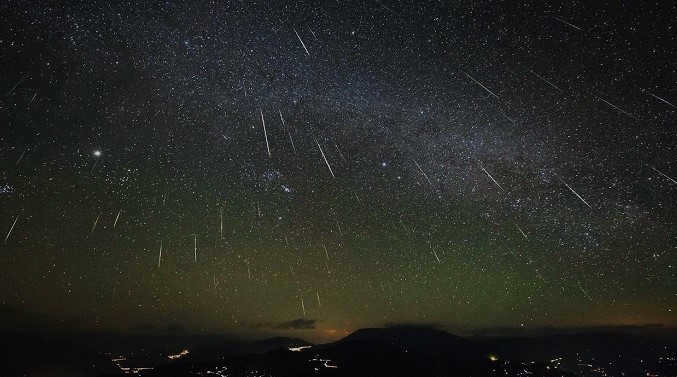
Besides, there exists a star pattern within the constellation called the Small Dipper. It is made up of Polaris, along with Beta, Delta, Zeta, Eta, Epsilon, and Gamma. Interestingly, the shape of this star pattern bears a resemblance to the Big Dipper. One could argue that even in this aspect, the constellation of the Little Bear closely resembles its larger counterpart.
The Little Bear constellation is visible throughout the year, making it constantly visible. To locate it, you should search in the latitude range of +900 to -00.
Despite its small size, the Little Bear constellation is a fascinating section of the sky. Each part of it seems to play a significant role in a larger whole. It is undeniably a vibrant and stunning constellation that deserves our attention.
As someone who resides in the city, observing constellations can be challenging. However, the Polar Bear constellation can be spotted even from the outskirts of St. Petersburg, making it accessible to anyone on a clear day. I am aware of two methods to locate the Little Bear.
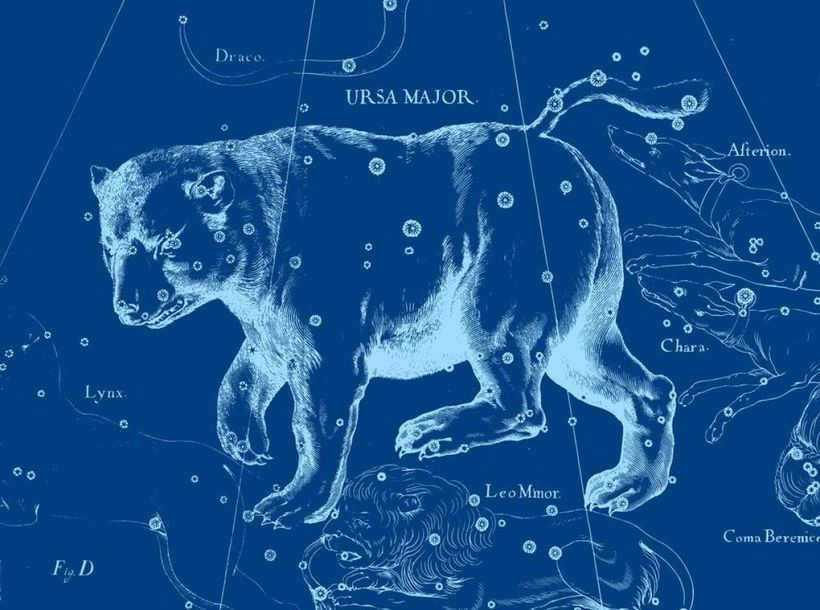
Steps to Locate the Little Bear
Although I may not be an expert in astronomy, I have my own techniques:
Allow me to explain:
The Conventional Approach: Locating the Little Bear
This approach not only enables you to locate the Little Bear, but also the Big Dipper. It requires some visual aids and guidance.
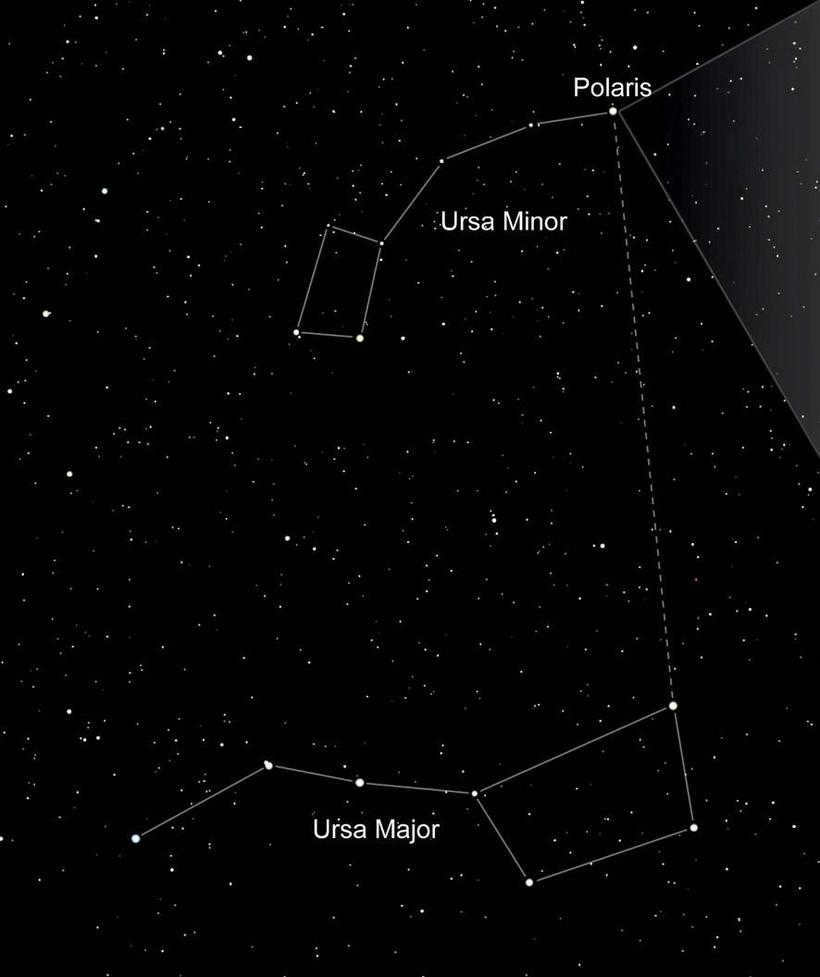
- Make sure to commit to memory the appearance of these constellations. Try to memorize how the stars are arranged. You can bring the drawing with you to make it easier to locate the stars in the sky.
- First and foremost, search for the Big Dipper in the sky. The stars in this constellation are luminous, so it shouldn’t be difficult to find it by comparing it to the picture. Have you found it?
- Just above the Big Dipper, search for Polaris. It is bright and aligns with the two stars of the Big Dipper.
- Polaris is the furthest star in the handle known as the handle of the Little Bear’s dipper. Use the illustration to locate the other points of the constellation.
- Keep in mind that the handles of the bucket in the Little Dipper and the Big Dipper always point in opposite directions.
Now that you have discovered the constellations based on the drawing, attempt to locate them independently. By practicing in this manner, you will acquire the ability to identify these constellations without any assistance.
How to locate the Ursa Minor: the “advanced” technique
Interestingly, there are mobile and tablet applications available that enable you to locate the Ursa Minor and other celestial objects in the night sky.
Instructions for using an app to find what you are looking for:
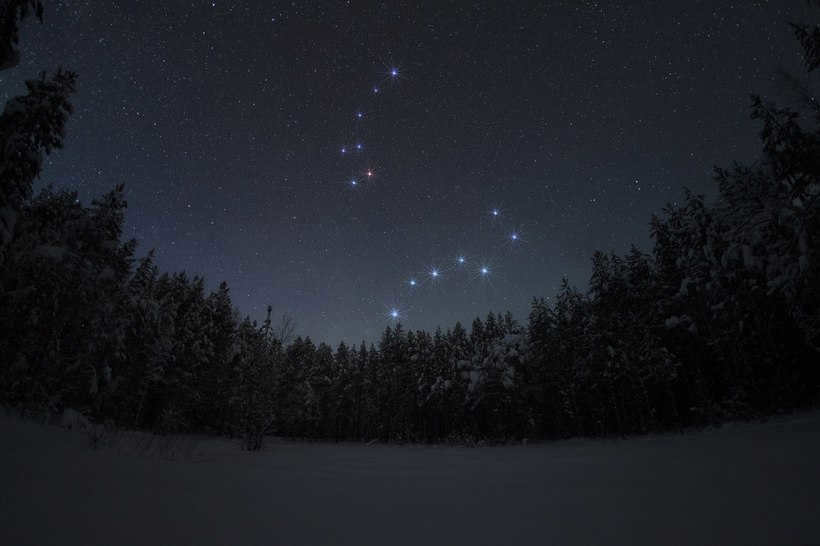
- Download the app.
- Make sure to input your current position.
- Direct your device’s camera towards the specific area of the sky where you wish to locate a star or group of stars.
- The application will display the names of the stars and highlight the constellations that are visible through the camera.
I personally favor the second approach. I don’t depend solely on my vision and recollection, and even if I’m able to locate the Little Dipper and the Big Dipper, finding the other constellations can be quite challenging. However, with the assistance of the app, navigation becomes seamless even under unfavorable visibility conditions.
Moreover, this app offers the opportunity to acquire knowledge about various star names.
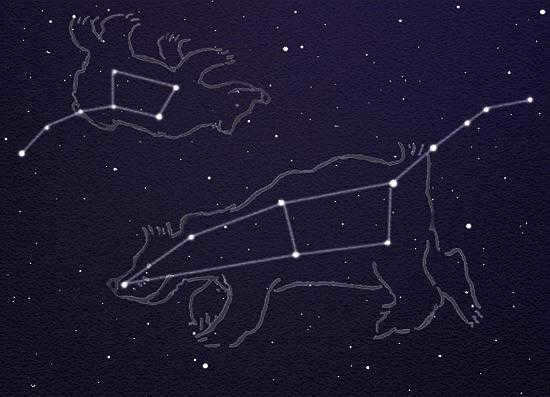
Research articles
This article presents a concise overview of the Little Bear constellation, which is situated in the northern hemisphere.
An account of the Little Bear constellation
The Little Bear is closely associated with the Big Dipper, not only in terms of folklore and mythology, but also in its proximity in the night sky: it extends from the line formed by the stars of the Big Dipper’s handle, Merak and Dubhe.
The tale of the Little Bear constellation
The story of this constellation is intertwined with the life of Callisto, the daughter of the Arcadian king. Callisto possessed an unparalleled beauty that captured the attention of the mighty Zeus. To approach her, Zeus disguised himself as Artemis, the goddess whom Callisto served. Eventually, Callisto gave birth to a son named Arcades. When Hera, the jealous wife of the ruler of Olympus, discovered this, she transformed the lovely servant girl into a bear.
What is the appearance of the Little Bear?
The ancient Greeks, considering the bear as a rare and exotic creature, depicted it in the sky with a unique feature – a curved, elongated tail that is not present in real bears. The constellation is also known as Kinosura, which translates to “dog’s tail”.
How many stars are present in the Little Bear?
Compared to other constellations, the Little Bear is relatively small in size. It is located in the northern hemisphere and can be seen with the naked eye, but only under ideal conditions can you observe 25 stars within it. Among these stars, the three brightest are α, β, and γ.
The brightest star in the Little Bear is Polaris (α). It is situated very close to the celestial pole and remains nearly stationary, while the other stars appear to “move” around it. Polaris is a massive star, much hotter than the Sun, and it has two companion stars.
Cohab (β) of the Little Bear is nearly equal in brilliance to Polaris. It has an orange hue and exhibits a spectral structure. Kohab is cooler than the Sun, despite being 40 times larger. Additionally, it is significantly brighter than our own star.
The star Ferkad (γ) also falls into the category of giant stars. It is hotter than Kohab and Polaris, but due to its greater distance, Ferkad appears less bright in comparison.
The three most luminous stars of the Little Bear collectively form the asterism known as the Guardians of the Pole.
We trust that the information about the Big Dipper has expanded your understanding of astronomy. Feel free to share your thoughts on the Big Dipper in the comment section below.
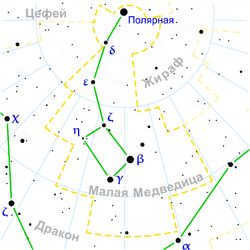
Ursa Minor, also known as the Little Dipper, is a constellation that can be seen all year round in the Northern Hemisphere. It covers an area of 255.9 square degrees in the sky and contains 40 stars that can be seen without the use of a telescope.
Currently, the North Pole of the world is located in the Little Bear, approximately 1° away from Polaris. It is believed that the constellation was identified by the Phoenicians for its navigational significance.
Stars
The most brilliant stars in the constellation include:
- Polaris (α UMi) with a stellar magnitude of 2.02 m.
- Cohab (β UMi) with a visible stellar magnitude of 2.08 m. From around 2000 BCE to 500 CE, Cohab served as the brightest star closest to the North Pole and acted as a pole star, hence its Arabic name Kohab al-Shemali (Star of the North).
- Ferkad (γ UMi) with a stellar magnitude of 3.05 m.
Asterisms
Asterism Small Bucket creates a distinctive and memorable pattern in the celestial sphere. It consists of seven stars – α (Polaris), β (Kohab), γ (Ferkad), δ, ε, ζ, and η of the Little Dipper. The Small Bucket has a similar shape to the nearby Big Dipper asterism in the constellation Ursa Major.
The outermost stars of the Bucket (Kohab and Ferkad) form the asterism known as the Guardians of the Pole.
Thales of Miletus is credited by Hyginus with introducing this constellation to ancient astronomy. It is also listed in Claudius Ptolemy’s Almagest, a catalog of the starry sky.
According to Greek mythology, Arcades, either the son of Callisto and Zeus or one of Callisto’s nymph friends, was transformed into this constellation. The Big Dipper constellation is also related to this.
The story of Zeus’s birth is also connected to the constellation known as the Little Dipper. In order to protect her son from his father Cronus, who had a habit of eating his own children, the goddess Gaia took Zeus to the top of Mount Ida and placed him in a sacred cave under the care of the nymphs Melissa and Kinosura. As a token of gratitude, Zeus later transformed Melissa into the Big Dipper and Kinosura into the Little Dipper. In some ancient maps, the Little Dipper (or sometimes just the star Polaris) is referred to as Kinosura, which means “dog’s tail.” It’s worth noting that in earlier versions of the myth, Melissa and Kinosura were actually Medes who were later transformed into nymphs.
Unlike the Greeks, who used the Big Dipper for navigation, the Phoenicians, who were renowned as skilled navigators in ancient times, relied on the Little Dipper for their navigational purposes. This was because they found it to be a more accurate guide.
The inhabitants of Kazakhstan referred to Polaris as the “iron nail” (Temir-Kazyk), driven into the sky, and in the remaining stars of the Little Dipper, they perceived a harness fastened to this nail, encircling the neck of the Horse (constellation of the Big Dipper). The Arabs confused the stars of the Little Dipper for horsemen, while the Persians interpreted it as the Seven Fruits of the Date Palm.





